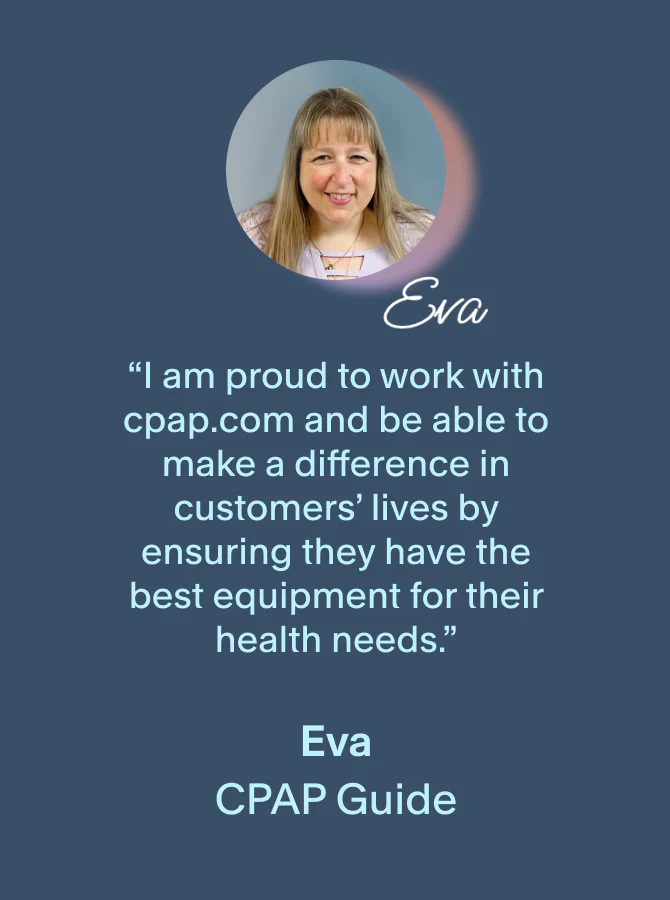Our content undergoes rigorous expert review, evidence-based research, and regular updates for accuracy.
If you're not aware, a lot has changed for both of these CPAP machines in the last year, so we've updated this comparison article of the Dreamstation and AirSense 10 to reflect our current recommendations.
The Philips DreamStation was discontinued, following the debut of the DreamStation 2, and the AirSense 10 is now available as the AirSense 10 AutoSet Card-to-Cloud. We highly recommend the AirSense 10 Card-to-Cloud to anyone looking to replace their recalled DreamStation CPAP.

In 2020, the DreamStation vs. AirSense 10 debate was in full swing. The race, for many, seemed too close to call. Admittedly, these machines were quite similar in many regards, as good competitors should be. Unfortunately, the CPAP world (and indeed, the world itself) has seen some drastic changes in the wake of the COVID-19 pandemic, which was further exacerbated when Philips announced the largest CPAP machine recall to date.
We’ll break down exactly how the world of CPAP has evolved in the following section, but what you need to know for now is that the DreamStation CPAP machine is no longer a viable option for those seeking a new sleep apnea device. Alternatively, the AirSense 10 AutoSet is only available as the budget-friendly “Card-to-Cloud” model and no longer supports wireless data tracking or ResMed’s MyAir companion app, but the AirSense 10 Card-to-Cloud does come with an SD card to monitor your therapy data and compliance.
While the AirSense 10 AutoSet remains our top pick between these two devices, we’d still like to offer an unbiased comparison for DreamStation owners that may be contemplating a new ResMed machine.
In this article, you’ll find a feature-by-feature breakdown of what each machine offers and which is better in each category.
First, however, let’s take a closer look at the Philips CPAP recall and the return of the AirSense 10 (Card-to-Cloud).
In a hurry? Skip to our comparison chart of these two machines below.
What's Changed?
The DreamStation CPAP machine was an absolute favorite and industry leader for years, but in 2021, it was involved in a global CPAP recall that left millions of people questioning the safety of their therapy devices. All models of the DreamStation and DreamStation Go were recalled, leaving the AirSense 10 AutoSet as the only machine out of the two that we feel comfortable recommending in 2024.
On top of the Philips CPAP recall, the impacts of the COVID-19 pandemic manifested as supply chain disruptions and widespread shortages. Most notably, a semiconductor chip shortage hampered production efforts across multiple industries and also led to a shortage in the supply of CPAP machines.
During this time, Philips Respironics released the DreamStation 2 (which was unaffected by the recall), and ResMed released the new AirSense 11 AutoSet, marking the official end of the AirSense 10.
However, in 2024, it remains unclear when or if the Philips DreamStation 2 will return to the market. Unfortunately, that means it’s nearly impossible to get your hands on a DreamStation 2 CPAP machine while Philips repairs and replaces devices impacted by the recall.
To get CPAP machines into the hands of those in need, ResMed also temporarily revived the AirSense 10 AutoSet, electing to remove its wireless modem to reduce the need for semiconductor chips. The AirSense 10 AutoSet Card-to-Cloud tracks therapy data on an SD card rather than using the cellular modem to wirelessly transmit it to your care or insurance provider. It’s also a more affordable option compared to the newer and more advanced AirSense 11, making it an attractive machine for those that aren’t concerned with regular compliance reports.
Now that you’re up to speed, let’s take a high-level overview of what each machine brings to the table.
Philips DreamStation vs. ResMed AirSense 10 AutoSet Card-to-Cloud
AirSense 10 Auto Card-to-Cloud DreamStation
| Noise Level | 26.6 dBa | 25.8 dBa |
| Humidification | Built-In | Optional |
| Comfort Features | SmartStart/Stop, Humidifier Warmup, Ramp/AutoRamp, Pressure Relief, Mask Fit | Auto Start/Stop, Humidifier Preheat, Ramp/SmartRamp, Pressure Relief, Mask Fit |
| Weight With Humidifier | 2.75 lb | 3.16 lb (1.56 lb Without Humidifier) |
| Size With Humidifier | 10” L x 4.6” W x 5.9” H | 11.7” L x 7.6” W x 3.3” H (6.2” L x 7.6” W x 3.3” H Without Humidifier) |
| Design | Sleek Black Design With a Tall, Thin Profile | Glossy White Design With a Short, Boxy Shape |
| Therapy Tracking Ability? | Yes via SD Card | Yes |
| Heated Tubing Available? | ClimateLineAir Heated Tube | Heated Tube for DreamStation Machines |
| Optional Batteries | Medistrom Pilot-24 Lite, Portable Outlet UPS, EXP96 Pro, EXP48 Pro, Freedom V2 Travel Battery, Zopec Power Outlet 2, & ResMed Power Station II | Medistrom Pilot-12 Lite, Freedom V2 Travel Battery, EXP96 Pro, EXP48 Pro, Respironics Travel Battery, Portable Outlet UPS, & Zopec Power Outlet 2 |
Sound Comparison
Are you a light sleeper? Is your CPAP machine’s sound output one of the most important qualities to you and your sleeping companion? Since you are using your machine while you’re sleeping, you would ideally want the quietest CPAP machine possible. Both the AirSense 10 and the DreamStation are classified as whisper-quiet.
The sound level of the AirSense 10 is slightly higher at 26.6 decibels. The DreamStation had a sound level of 25.8 decibels. However, they are close enough that this feature is not a standout for one machine over the other. The AirSense 10 Card-to-Cloud is currently the quietest CPAP machine on the market, making it ideal for light sleepers. If you want to make it even quieter and don’t use the built-in humidifier, you can purchase the optional AirSense 10 Side Cover to reduce your CPAP machine noise even further.
Humidification
Hot or cold air humidification can be an important factor in your sleep apnea therapy. Humidification benefits you by encouraging mucus production and helping your body keep from drying out from the consistent flow of pressurized air. It can make CPAP therapy much more comfortable and approachable, though it’s not a requirement for successful therapy.
When choosing your ideal CPAP machine, note that some units are designed with humidification systems built-in (like the AirSense 10 Card-to-Cloud), and some are only available as an add-on for an additional cost (DreamStation). Both machines feature adjustable levels of humidification and optional heated tubing. To customize your CPAP therapy to your specific needs, the AirSense 10 has eight levels of control whereas the DreamStation only had five.
A key selling point of the AirSense 10 Card-to-Cloud is the built-in HumidAir Humidifier, which provides a humidification element in the standard footprint of the machine without needing to attach any other equipment, making it more travel-friendly and cost-effective. The humidification system can help ease any dryness you may be experiencing in your nose, throat, or mouth. Both the temperature and humidity are automatically set for maximum comfortability, but they can also be adjusted to fit your specific needs.
On the other hand, the DreamStation’s humidifier was optional, an additional cost, and needed to be separately attached. The humidifier nearly doubled the length of the machine, resulting in a bigger footprint on your nightstand or in your travel bag.
Weight
Here’s where having a built-in humidifier sets the AirSense 10 Card-to-Cloud apart from the Philips DreamStation. The AirSense 10 Card-to-Cloud weighs 2.75 pounds with the built-in humidifier while the DreamStation weighed 3.16 pounds with its optional humidifier. This means that with humidification, the AirSense 10 wins when it comes to weight.
However, if humidification is not an important feature to you, the DreamStation did weigh over a pound less than the AirSense 10 at just 1.56 pounds without the humidifier attached. If you’re someone who plans to travel with your machine and you want the added benefits of humidification, the AirSense 10 is the winner.
Size
When it comes to traveling, the compact size of your machine matters. The AirSense 10 Card-to-Cloud measures 10” L x 4.6” W x 5.9” H and the DreamStation measured 6.2” L x 7.6” W x 3.3” H without the humidifier installed. The DreamStation with the humidifier was 11.7” L x 7.6” W x 3.3” H.
If having the smallest size machine for travel without humidification is at the top of your CPAP wish list, then the DreamStation without the humidifier was the more compact option. However, if you want the added benefits of humidification, the AirSense 10 is an overall more compact package with its integrated humidifier.
Design
These machines offer a stark contrast when it comes to the overall design of each unit. The AirSense 10 features a tall and thin profile with black body panels and a small overall footprint. On the other hand, the DreamStation was short, wide, white, and flat. The AirSense 10’s integrated humidifier seamlessly provides humidification for those that prefer it, but if you did want to use humidification with your DreamStation device, it would have nearly doubled in size.
Ultimately, it comes down to your preference for humidification, regarding if the machine design would be altered and whether or not you want to use it with your therapy. Both machines use a rotating dial and color LCD to access the menus, and both offer an optional heated hose as well.
Pressure Relief Features
The ResMed AirSense 10 Card-to-Cloud comes equipped with a pressure relief feature, using an algorithm called Expiratory Pressure Relief (EPR). The DreamStation also features exhalation relief in the form of A-Flex. Both systems work to reduce the pressure you’ll feel when exhaling, allowing for a more natural breathing experience by not having to breathe against your air pressure.
The Respironics DreamStation included a physical button to activate the Ramp feature for added convenience. For the AirSense 10 AutoSet, the Ramp feature is accessed through the menus, which may be a challenge when using the device at night or when you are groggy. Both machines feature automatic pressure adjustments and will automatically start and stop your therapy when you put on or remove your mask.
Therapy Tracking
The DreamStation had Bluetooth capability, which allowed you to track your therapy through the DreamMapper app. Your data from your previous night of sleep was transferred immediately to the app and showed your pressure, leak rate, and AHI. In addition, it would detail your number of apneas and hypopneas.
While previous iterations of the AirSense 10 used the MyAir app to help you track your therapy data, the Card-to-Cloud model is only able to track your therapy data via the included SD card. However, the Essentials Plus view will be enabled on the Card-to-Cloud machines, allowing you to view your comprehensive sleep apnea therapy data on the machine itself. You’ll still need to get your SD card to your healthcare provider for compliance reports and check-ups.
Battery Options
If you’re planning on taking your machine on the go, CPAP batteries give you more freedom and flexibility when it comes to powering your CPAP machine. In the event of a power outage, battery backups, like the Portable Outlet UPS Battery, can help you keep your therapy up and running by automatically switching to battery power. However, not all batteries have this function.
The DreamStation operated on a 12V current, making it compatible with the largely popular, Medistrom Pilot-12 Lite. The Respironics Travel Battery Kit is also available and was specifically designed for the DreamStation series of machines.
Though it operates at 24V instead of 12V, the AirSense 10 Card-to-Cloud is not without battery options. The AirSense 10 AutoSet is compatible with the Medistrom Pilot 24-Lite, which is specifically designed to provide battery power for 24V CPAP machines. There’s also the ResMed Power Station II, a proprietary battery for ResMed machines.
In terms of universal options, both the DreamStation and AirSense 10 can be powered by the Zopec Power Outlet II, Portable Outlet UPS Battery, EXP96 Pro, EXP48 Pro, and Freedom V2 Travel Battery.
Related Reading: Best CPAP Batteries
Final Thoughts: ResMed AirSense 10 or Philips Respironics DreamStation?
On paper, the Respironics DreamStation and the ResMed AirSense 10 Card-to-Cloud are very similar and capable machines. Both come equipped with several automated features, including automatically adjusting air pressure, a Ramp feature, and heated humidification—all while operating at under the whisper-quiet 27 decibels. Both machines are also universally compatible with all CPAP masks and standard tubing—with options for heated tubing as well.
In conclusion, the DreamStation was a part of the global Philips recall and is no longer available for purchase. The AirSense 10 Card-to-Cloud is the only machine out of the two that is still on the market in 2024. Luckily, the AirSense 10 isn’t just the winner by happenstance and is backed by industry-leading comfort features, build quality, and reliable performance.
If you’re in need of a compact top-notch, feature-packed, and easy-to-use CPAP machine, we can’t say enough good things about the AirSense 10 AutoSet Card-to-Cloud.








